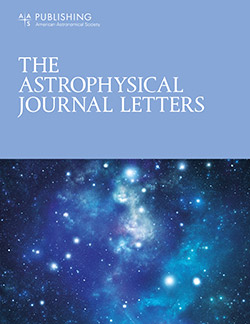The Transient Outgassed Atmosphere of 55 Cancri e
IF 8.8
1区 物理与天体物理
Q1 ASTRONOMY & ASTROPHYSICS
引用次数: 0
Abstract
Abstract The enigmatic nature of 55 Cancri e has defied theoretical explanation. Any explanation needs to account for the observed variability of its secondary eclipse depth, which is at times consistent with zero in the visible/optical range of wavelengths—a phenomenon that does not occur with its also variable infrared eclipses. Yet despite this variability, its transit depth remains somewhat constant in time and is inconsistent with opaque material filling its Hill sphere. The current study explores the possibility of a thin, transient, secondary atmosphere on 55 Cancri e that is sourced by geochemical outgassing. Its transient nature derives from the inability of outgassing to be balanced by atmospheric escape. As the outgassed atmosphere escapes and is replenished, it rapidly adjusts to radiative equilibrium and the temperature fluctuations cause the infrared eclipse depths to vary. Atmospheres of pure carbon dioxide or carbon monoxide produce sufficient Rayleigh scattering to explain the observed optical/visible eclipse depths, which vanish in the absence of an atmosphere and the presence of a dark rocky surface. Atmospheres of pure methane are ruled out, because they produce insufficient Rayleigh scattering. Upcoming observations by the James Webb Space Telescope will potentially allow the atmospheric temperature and surface pressure, as well as the surface temperature, to be measured.巨蟹座55e的瞬态排气大气层
巨蟹座55 e的神秘性质一直无法从理论上解释。任何解释都需要考虑到观测到的二次月食深度的变化,在可见光/光学波长范围内,这种变化有时为零——这种现象不会发生在同样变化的红外月食上。然而,尽管这种变化,它的过境深度在时间上保持一定的恒定,并且与填充希尔球的不透明物质不一致。目前的研究探索了在巨蟹座55 e上存在一种稀薄、短暂的次级大气的可能性,这种大气是由地球化学释气产生的。它的短暂性是由于放出气体不能被大气逸出所平衡。当被释放的大气逸出并被补充时,它迅速调整到辐射平衡,温度波动导致红外日食深度的变化。纯二氧化碳或一氧化碳的大气产生足够的瑞利散射来解释观测到的光学/可见的日食深度,这种深度在没有大气和存在黑暗岩石表面的情况下消失。纯甲烷的大气被排除在外,因为它们产生的瑞利散射不足。詹姆斯·韦伯太空望远镜即将进行的观测将有可能测量大气温度、表面压力以及表面温度。
本文章由计算机程序翻译,如有差异,请以英文原文为准。
求助全文
约1分钟内获得全文
求助全文
来源期刊

Astrophysical Journal Letters
ASTRONOMY & ASTROPHYSICS-
CiteScore
14.10
自引率
6.30%
发文量
513
审稿时长
2-3 weeks
期刊介绍:
The Astrophysical Journal Letters (ApJL) is widely regarded as the foremost journal for swiftly disseminating groundbreaking astronomical research. It focuses on concise reports that highlight pivotal advancements in the field of astrophysics. By prioritizing timeliness and the generation of immediate interest among researchers, ApJL showcases articles featuring novel discoveries and critical findings that have a profound effect on the scientific community. Moreover, ApJL ensures that published articles are comprehensive in their scope, presenting context that can be readily comprehensible to scientists who may not possess expertise in the specific disciplines covered.
 求助内容:
求助内容: 应助结果提醒方式:
应助结果提醒方式:


